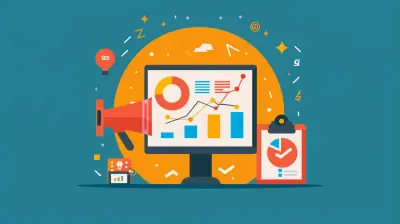How to Leverage Big Data for Smarter Marketing Decisions
9 August 2025
Let’s face it — marketing today isn’t just about catchy slogans or pretty visuals. It’s a data-driven game. And the real MVP? Big data. If you’re not tapping into big data, you’re pretty much flying blind in a storm. Smart marketers are using it to dig deep and make strategic decisions that actually work. So, how can you hop on board and turn raw numbers into marketing magic? Buckle up, because we’re diving headfirst into the world of big data and how it can revolutionize your marketing strategy.
What Is Big Data Anyway?
Before we jump in, let’s simplify the term “big data.” Picture every interaction your customer has with your brand—every click, purchase, search, social media like, and email open. Now imagine collecting all that info… from all your customers… over months and years. That’s big data.But it’s not just about volume. It’s also about variety (texts, videos, stats), velocity (real-time and fast), and veracity (how accurate it is). That’s what makes it ‘big’. And big data isn’t useful on its own — the real power lies in how you use it.
Why Big Data is a Game-Changer in Marketing
Ever heard the saying, “Knowledge is power”? Big data hands you the knowledge you need to make decisions that actually hit home with your audience.It answers questions like:
- Who are your best customers?
- What content grabs their attention?
- When are they most likely to buy?
- Why do they abandon their carts?
- Which channels work best?
With this kind of insight, you’re not just guessing anymore—you’re making informed, strategic moves.
Benefits of Leveraging Big Data in Marketing
Before we get into the how-to, let’s look at some of the core benefits:🎯 1. Hyper-Personalization
Big data lets you get super-specific. You’re not just sending the same ad to everyone. You’re targeting Sarah with pet supplies because she just adopted a dog last week, and offering Mike a skiing gear discount because, well, winter’s coming.⏱ 2. Real-Time Decision Making
Need to tweak a campaign on the fly? Big data helps you monitor performance in real-time, so if something’s off—you can adjust before it’s too late.📈 3. Improved ROI
By analyzing which strategies bring the most value, you can invest more in what’s working and ditch what’s not. That’s money saved and results gained.💡 4. Better Customer Experiences
Big data helps create smoother, more intuitive customer journeys. When your marketing feels seamless and relevant, customers notice—and they keep coming back.
How to Leverage Big Data for Smarter Marketing Decisions
Okay, let’s get into the core of it. How do you actually use big data to boost your marketing game?1. Collect the Right Data
Let’s be real—you can’t use what you don’t have.So, start by identifying where your data lives. Some solid sources include:
- Website analytics (Google Analytics, Hotjar)
- Social media insights
- Email marketing platforms (like Mailchimp or HubSpot)
- CRM systems
- Transaction history
- Customer feedback and reviews
Pro tip: Avoid drowning in data. Focus on metrics that align with your business goals.
2. Segment Your Audience Like a Pro
You know that “one-size-fits-all” approach? Toss it out.Big data allows you to break down your audience into detailed segments—based on things like age, location, behavior, purchase history, and even device usage.
For example:
- New vs returning customers
- High spenders vs bargain hunters
- Morning shoppers vs night owls
The more targeted your messaging, the more likely you’ll hit the mark.
3. Predict Customer Behavior with Analytics
Imagine having a crystal ball that told you what your customers will do next. Big data is basically that.By analyzing past behavior, machine learning models can predict future actions. Think:
- When a customer is likely to churn
- Which products a customer might want next
- The best time to send an email
This kind of predictive power lets you stay one step ahead.
4. Create Personalized Marketing Campaigns
Ever visited a website, left without buying, and then saw the same product follow you around the internet? Creepy? Maybe a little. Effective? Absolutely.That’s personalized marketing in action. Big data powers this by helping you customize:
- Email content
- Product recommendations
- Retargeting ads
- Landing pages
The result? Higher engagement and conversions.
5. Optimize Channels and Touchpoints
Your customers don’t follow a straight line from awareness to purchase. They bounce from social media to emails to your website and back again.Big data can show you which touchpoints are most effective—and which ones need work. That means you can:
- Invest more in high-performing channels
- Improve underperforming ones
- Align your messaging across platforms
It’s all about meeting your customers where they are.
6. A/B Test and Iterate
Big data takes the guesswork out of A/B testing. Instead of relying on gut feelings, you use actual data to see what works best.Test things like:
- Subject lines
- CTAs
- Ad visuals
- Landing page layouts
Then scale what works and ditch what doesn’t. Rinse and repeat.
7. Monitor Campaign Performance In Real Time
Don’t wait weeks to find out if your campaign flopped. With big data tools and dashboards, you can track performance as it happens.Want to know your click-through rate right now? Or how many people abandoned their cart today? Big data’s got you covered—and lets you adjust on the fly.
8. Leverage Social Listening
Big data isn’t just about numbers. It’s also about what people are saying.Social listening tools (like Brandwatch or Sprout Social) let you track conversations and mentions. This kind of intel is gold for:
- Understanding customer sentiment
- Spotting trends
- Managing your reputation
And yes—it can help you craft content that actually resonates.
Real-World Examples of Big Data in Marketing
Let’s pull back the curtain on how some brands are rocking big data.🎵 Spotify
Ever wonder how Spotify nails your Discover Weekly playlist? Yep, that’s big data. By analyzing your listening habits, it recommends tracks you’re likely to love—which keeps you on the platform longer.🛒 Amazon
Amazon’s recommendation engine is legendary. It uses your browsing, purchase history, and even what’s in your cart to suggest products. That personalization drives billions in sales.☕ Starbucks
Starbucks uses data from its rewards app to recommend drinks, personalize offers, and even choose new store locations. They know what you like probably before you do.Common Pitfalls to Avoid
Alright, not to be a downer, but let’s talk about what to steer clear of.❌ Collecting Too Much Irrelevant Data
More isn’t always better. Focus on what actually helps you make better decisions.❌ Ignoring Data Privacy
GDPR, CCPA… the list goes on. Respect customer privacy and be transparent about how you collect and use data.❌ Neglecting Human Intuition
Data is powerful, but it’s not infallible. Blend it with human creativity and common sense for best results.Tools to Help You Get Started
You don’t need to be a data scientist to use big data. Here are some user-friendly tools:- Google Analytics – Essential for website insights
- HubSpot – Tracks user behavior, email campaigns, and lead scoring
- Tableau – Visualize your data beautifully
- R or Python – For the more technical marketers
- Adobe Analytics – Deep marketing analytics
- Hootsuite Insights – Social listening and analytics
The Future of Big Data in Marketing
We’re just scratching the surface. With AI, machine learning, and deeper integrations, big data is only getting bigger—and smarter.Expect more automation, real-time personalization, and even predictive content creation. The tools will get better, but the goal stays the same: know your audience, serve them better, and grow your business.
Final Thoughts
Big data isn’t just for tech giants with massive budgets. It’s for you, the modern marketer who wants to be better, faster, and smarter. By collecting the right data, understanding what it means, and acting on it—you’re not just keeping up. You’re getting ahead.Marketing without data is like driving at night with the headlights off. So turn those lights on and start making smarter decisions.
Because when you know more, you market better. Simple as that.
all images in this post were generated using AI tools
Category:
Digital MarketingAuthor:

Susanna Erickson
Discussion
rate this article
1 comments
Miriam Perez
This article highlights the transformative power of big data in marketing. It offers valuable insights into how businesses can harness analytics to make informed decisions, optimize campaigns, and better understand their audiences. Embracing these strategies is essential for staying competitive in today’s data-driven landscape. Thought-provoking and timely!
August 14, 2025 at 11:29 AM

Susanna Erickson
Thank you for your thoughtful comment! I'm glad you found the article insightful and timely in highlighting the importance of big data in marketing.


